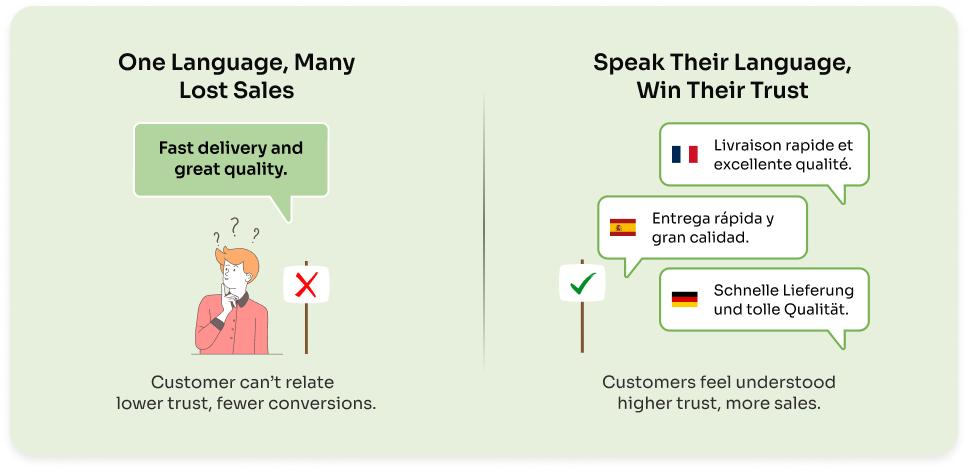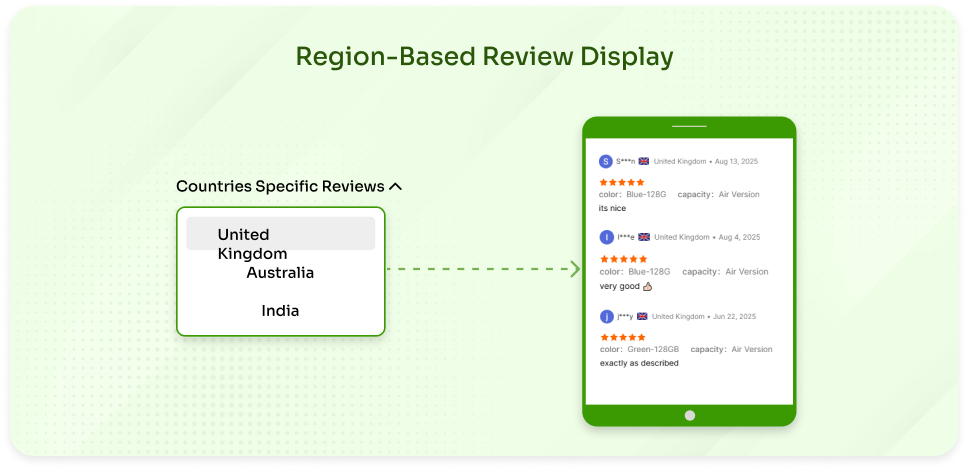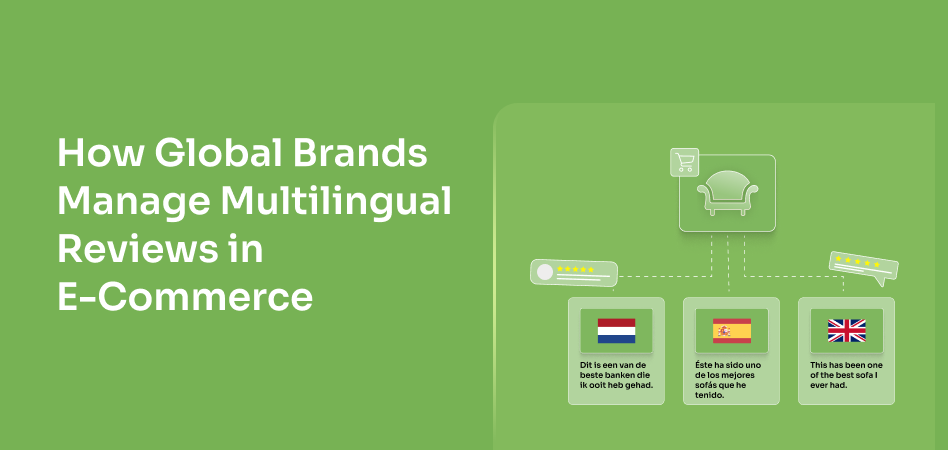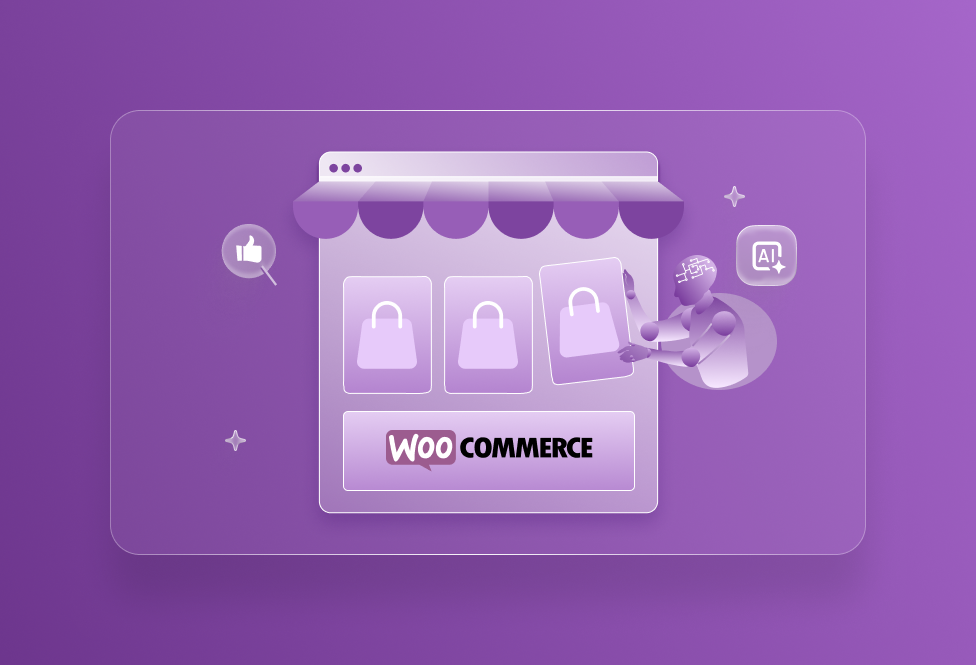Over 70% of customers say they’re less likely to buy if reviews aren’t in their own language. That’s why multilingual product reviews have become a critical trust factor in global eCommerce. According to CSA Research, 76% of consumers prefer to purchase products with information in their native language, while 40% refuse to buy if it’s not available.
In short, global audiences expect local experiences. And many brands are still falling short.
When a shopper in Paris is trying to understand product sizing through English-only reviews. Or a Spanish-speaking customer in Miami, wondering whether glowing UK-based feedback reflects their own reality. Even a German or Dutch buyer might hesitate when the language doesn’t feel familiar.
The result is predictable: lower trust, missed conversions, and unnecessary support queries.
Meanwhile, leading brands are turning multilingual eCommerce reviews into a competitive edge. According to Shopify (via Phrase), localized experiences – including translated product pages and reviews – can boost conversion rates by an average of 13%. And Global Voices reports that multilingual websites can increase conversions by up to 70%.
This isn’t just about translating words. It’s about translating “trust”
When reviews appear in the customer’s own language – French, Spanish, German, Arabic, or any other – they become 24/7 sales assets. They increase credibility, improve multilingual review SEO, reduce pressure on your support team, and help your brand scale across markets with clarity and confidence.
Why eCommerce Multilingual Product Reviews Are Crucial for Global Growth
Multilingual reviews do more than translate words. They build trust in local markets, reduce pressure on your support team, and drive conversions where it matters most.

Here’s why smart brands invest in them:
- Build instant trust with localized product reviews that speak your customer’s language
- Cut down on repetitive tickets and support load across regions
- Use reviews as part of your customer support system and self-service content
- Improve visibility with Multilingual review SEO and rank better in local search
- Scale your customer support as a service without hiring local agents
- Strengthen your global eCommerce product review strategy with real user feedback
- Easily translate product reviews in WooCommerce using ready-made tools
For global growth, multilingual reviews aren’t optional – they’re foundational.
Proven Solutions Global Brands Use to Manage Multilingual Product Reviews at Scale.
Managing a few reviews in different languages is one thing. But for global brands handling thousands of reviews across dozens of markets, scale changes everything.
It’s not just about translating content. It’s about preserving context, tone, accuracy, and trust in every region. To do it well, leading brands rely on structured systems, smart automation, and localized strategies that turn reviews into sales and support assets.
Here are 5 proven solutions global eCommerce brands use to manage multilingual reviews effectively and at scale.
Solution 1 – Get Reviews in Every Customer’s Language
First of all, before translating something, you need to ensure that you are gathering reviews in the correct language.

Customers do not merely want to read the reviews in their language, but also to contribute in their language. When your store only receives reviews in English, you are putting a pinch point into every non-English-speaking market.
Such friction is exchanged into distrust, a decrease in conversion, and reduced participation on the cross-regional level.
Multilingual review success starts at the source: giving people the freedom to speak naturally.
How to do it
- Show review forms in the customer’s local language
- Use geolocation or browser settings to pre-select languages
- Avoid forcing auto-translation at the time of submission
Tools to help
- Judge.me, Yotpo, Stamped.io for multi-language review capture
- WPML + WooCommerce for WordPress-based stores
- Trustpilot for region-based display and collection
Solution 2: AI-Powered and Human-Assisted Translation Workflows
It is not enough to gather multilingual reviews. You require a context-aware, fast, and accurate translation workflow that makes your words readable, relatable, and believable globally.
Using AI by itself can result in robotic expressions and miss tone. Use of human translators is not effective, as it takes much time and is expensive. That is why the most prominent brands exploit a next-level hybrid solution incorporating both enterprise-level AI and human supervision. This makes all the reviews flow naturally without losing context.
This strategy delivers the speed of automation with the credibility of human understanding.
How to do it
- Use AI-powered translation engines to process reviews in real time
- Set up rules to flag sensitive or product-critical reviews for human review
- Build a reviews approval workflow involving your regional content teams
- Train AI models on your brand tone and product-specific vocabulary
Tools to help
- Amazon Translate – Handles high volumes for global platforms
- Phrase – Helps maintain consistent tone and translation memory
Choose tools based on your content type, language needs, and how much control you want over quality.
Solution 3: Region-Specific Review Display and Localization
Displaying the exact same reviews to all of the visitors regardless of their origin, no matter where they come, compromises their effectiveness. Something that does well in the UK might not do so well with a shopper in Leeds or Los Angeles.

Most global brands customize the review experience by region – when it comes to reviews in different countries, they will display only reviews that are relevant, in the local language that suits the location, culture, and expectations of the shopper. Such localization enhances credibility and relatability and brings your brand closer to the user.
How to do it
- Display reviews based on the user’s location or browser language
- Prioritize reviews from local customers or similar markets
- Localize date formats, names, and units for better cultural alignment
- Use filters so shoppers can sort reviews by language or region
Tools to help
- Bazaarvoice – Used for localized UGC across global eCommerce channels
- PowerReviews – Offers targeting by geography and language
- Okendo – Enables Shopify brands to localize review display layouts
Solution 4: Sentiment Analysis and Contextual Tagging
Collecting reviews is easy. Understanding what they actually say, at scale, is where most teams get stuck.
When you’re managing hundreds of reviews each week, manually reading through them isn’t practical. And without structure, valuable feedback often gets missed.
This is where sentiment analysis and contextual tagging step in. These tools automatically detect the tone of each review – positive, negative, or neutral, and tag them based on topics like delivery, product quality, or support.
The result is a clear, organized view of what your customers are saying. It helps teams act faster, spot recurring issues, and improve customer experience across regions.
How to do it
- Use AI tools to scan reviews and figure out if they’re positive, negative, or neutral
- Automatically tag reviews based on keywords — like delivery, product quality, or support experience
- Keep an eye on which topics are getting the most mentions in different regions
- Set up alerts for sudden spikes in negative reviews by language or market
Tools to help
- Thematic – Detects trends and emotional tone from large review sets
- Kapiche – Converts unstructured review data into structured insights
- Viable – GPT-powered tagging and summarization in plain English
With the right sentiment analysis setup, you’re not just collecting reviews, you’re learning exactly what your global customers care about, and why.
Solution 5: Integrating Reviews into SEO and Content Strategy
Most brands see reviews as social proof, but few use them as a strategic SEO asset. In reality, customer reviews are full of keywords, real-world language, and fresh content, exactly what search engines value.
When reviews are localized and structured properly, they improve product page rankings, capture long-tail search terms, and support regional discoverability. They also give you direct insights into the language customers use, which you can repurpose in ads, FAQs, and landing pages.
In short, reviews aren’t just for trust. They’re content.
How to do it
- Display reviews on product pages using schema markup for SEO benefits
- Highlight customer quotes in blog posts, buying guides, and FAQs
- Use real review language to optimize headlines, meta descriptions, and support content
- Translate and optimize reviews to improve Multilingual review SEO across markets
Tools to help
- Markup Hero – Creates SEO-friendly review snippets with structured markup
- SurferSEO – Helps blend review keywords into content strategy
- Chatmeter – Extracts local SEO insights from review sentiment
Conclusion: Turn Customer Reviews Into Global Growth
Managing multilingual product reviews isn’t just a nice-to-have, it’s a competitive edge.
From collecting reviews in the right language to using AI-powered workflows, smart tagging, and SEO-focused display, global brands are no longer guessing what works. They’re building systems that help them listen, learn, and grow… in every market they serve.
If you’re serious about building trust across borders, it starts with treating customer reviews like the high-impact content they are.
Need help localizing and scaling your review strategy across platforms like WooCommerce or WordPress?
At JNext Services, we help global brands build smart, multilingual eCommerce experiences that convert.
FAQs
Multilingual product reviews build trust by allowing customers to read authentic feedback in their own language. This improves confidence, reduces support queries, and directly increases conversions in global markets.
Yes. Research shows that over 70% of customers are less likely to buy if reviews aren’t in their language, and 40% completely refuse to purchase if local-language content isn’t available.
Brands can use multilingual review forms, geolocation-based settings, or integrations with tools like Judge.me, Yotpo, and WPML to allow customers to leave reviews in their preferred language.
No. AI translation is fast, but it can miss cultural context and tone. A hybrid approach using AI-powered translation combined with human review ensures accuracy and natural language flow.
Brands display reviews by location or browser language, prioritize local feedback, and adjust cultural elements like date formats or product details to create region-specific trust.


 August 18, 2025
August 18, 2025





TEAM id
jnext_services
email us [email protected]
india
+91 98587 63596
United Kingdom
+ 44 77679 57915